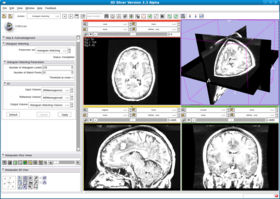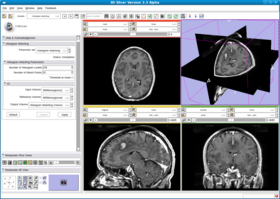Modules:HistogramMatching-Documentation-3.4
Return to Slicer 3.4 Documentation
Module Name
Histogram Matching
General Information
Module Type & Category
Type: CLI
Category: Filtering
Authors, Collaborators & Contact
- Author: Bill Lorensen
- Contact: bill.lorensen at gmail.com
Module Description
Normalizes the grayscale values of a source image based on the grayscale values of a reference image. This filter uses a histogram matching technique where the histograms of the two images are matched only at a specified number of quantile values. The filter was orginally designed to normalize MR images of the same MR protocol and same body part. The algorithm works best if background pixels are excluded from both the source and reference histograms. A simple background exclusion method is to exclude all pixels whose grayscale values are smaller than the mean grayscale value. ThresholdAtMeanIntensity switches on this simple background exclusion method. Number of match points governs the number of quantile values to be matched. The filter assumes that both the source and reference are of the same type and that the input and output image type have the same number of dimension and have scalar pixel types.
Usage
Examples, Use Cases & Tutorials
- Note use cases for which this module is especially appropriate, and/or link to examples.
- Link to examples of the module's use
- Link to any existing tutorials
Quick Tour of Features and Use
List all the panels in your interface, their features, what they mean, and how to use them. For instance:
- Input panel:
- Parameters panel:
- Output panel:
- Viewing panel:
Development
Dependencies
Other modules or packages that are required for this module's use.
Known bugs
Follow this link to the Slicer3 bug tracker.
Usability issues
Follow this link to the Slicer3 bug tracker. Please select the usability issue category when browsing or contributing.
Source code & documentation
Source Code: HistogramMatching.cxx
XML Description: HistogramMatching.xml
Usage:
./HistogramMatching [--processinformationaddress <std::string>] [--xml]
[--echo] [--threshold] [--numberOfMatchPoints
<int>] [--numberOfHistogramLevels <int>] [--]
[--version] [-h] <std::string> <std::string>
<std::string>
Where:
--processinformationaddress <std::string>
Address of a structure to store process information (progress, abort,
etc.). (default: 0)
--xml
Produce xml description of command line arguments (default: 0)
--echo
Echo the command line arguments (default: 0)
--threshold
If on, only pixels above the mean in each volume are thresholded.
(default: 0)
--numberOfMatchPoints <int>
The number of match points to use (default: 10)
--numberOfHistogramLevels <int>
The number of hisogram levels to use (default: 128)
--, --ignore_rest
Ignores the rest of the labeled arguments following this flag.
--version
Displays version information and exits.
-h, --help
Displays usage information and exits.
<std::string>
(required) Input volume to be filtered
<std::string>
(required) Input volume whose histogram will be matched
<std::string>
(required) Output volume. This is the input volume with intensities
matched to the reference volume.
Description: Normalizes the grayscale values of a source image based on
the grayscale values of a reference image. This filter uses a histogram
matching technique where the histograms of the two images are matched
only at a specified number of quantile values. The filter was orginally
designed to normalize MR images of the same MR protocol and same body
part. The algorithm works best if background pixels are excluded from
both the source and reference histograms. A simple background exclusion
method is to exclude all pixels whose grayscale values are smaller than
the mean grayscale value. ThresholdAtMeanIntensity switches on this
simple background exclusion method. Number of match points governs the
number of quantile values to be matched. The filter assumes that both
the source and reference are of the same type and that the input and
output image type have the same number of dimension and have scalar
pixel types.
Author(s): Bill Lorensen
Acknowledgements: This work is part of the National Alliance for Medical
Image Computing (NAMIC), funded by the National Institutes of Health
through the NIH Roadmap for Medical Research, Grant U54 EB005149.
More Information
Acknowledgment
This work is part of the National Alliance for Medical Image Computing (NAMIC), funded by the National Institutes of Health through the NIH Roadmap for Medical Research, Grant U54 EB005149. Information on the National Centers for Biomedical Computing can be obtained from National Centers for Biomedical Computing.


